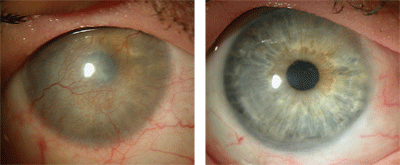Researchers in Italy used a small number of stem cells from the patient’s fellow eye, multiplied them in the lab and placed them on the damaged eye. They grew new corneal tissue to replace the damage. This treatment was a success in 82 of 113 eyes and a partial success in 14 eyes. Failures (11 eyes) all occurred within the first year post-graft, and results did not decrease acuity beneath baseline.
Patients’ limbal stem cell deficiency was caused by chemical burn (103), thermal burn (7), bacterial infection (2) and orbital irradiation (1). Of the total cohort, 84% of patients had undergone corrective surgery; all of these had failed. Patients ranged in age from 14 to 80, and the duration between injury and graft during the study ranged from 0.8 years to 56.4 years.
This
patient presented with limbal stem cell deficiency due to
Stevens-Johnson syndrome. Conjunctival limbal autograft from the fellow
eye resulted in a healed, smooth corneal surface with no
immunosuppression.

Photos: Scheffer Tseng, M.D., Ph.D.
Patients’ improvement was stable throughout the decade-long study. Complications included hemorrhage, residual fibrin on the third day post-op, inflammation, blepharitis with epithelial involvement and herpetic keratitis. All of these were treated successfully with standard therapy. A successful graft regenerated normal avascular corneal epithelium, but vision was only attainable if the original injury had not damaged the corneal stroma.
For those eyes with stromal scarring, corrective surgery one to two years post-graft—penetrating keratoplasty, lamellar keratoplasty or phototherapeutic keratectomy—replaced the damaged stroma.
Researchers saw no intraoperative complications and followed standard postoperative therapeutic protocols with normal results. After refractive surgery, permanent recovery of 0.6 (~20/32) to 1.0 (20/20) visual acuity was seen in 21 patients, and the other 25 gained up to 0.5 (20/40) visual acuity.
This treatment would most benefit patients with corneal chemical burns, say researchers. But, they add, it would not work for patients with damage to the optic nerve or macular degeneration, or for those patients who are completely blind in both eyes—doctors need at least some healthy tissue to transplant. And, an additional benefit of such stem cell autografts is that the patient does not need to take anti-rejection drugs. (For more on stem cell therapy for limbal stem cell deficiency, see “ Stem Cells to the Rescue.”)
Rama P, Matuska S, Paganoni G, et al. Limbal stem-cell therapy and long-term corneal regeneration. New Engl J Med. 2010 Jun 23. [Epub ahead of print]

